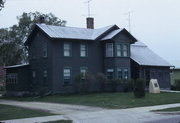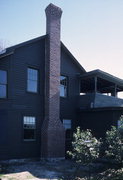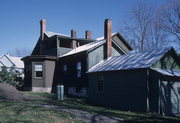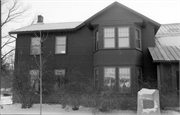Property Record
357 W GARLAND ST
Architecture and History Inventory
| Historic Name: | HAMLIN GARLAND HOUSE |
|---|---|
| Other Name: | |
| Contributing: | |
| Reference Number: | 29817 |
| Location (Address): | 357 W GARLAND ST |
|---|---|
| County: | La Crosse |
| City: | West Salem |
| Township/Village: | |
| Unincorporated Community: | |
| Town: | |
| Range: | |
| Direction: | |
| Section: | |
| Quarter Section: | |
| Quarter/Quarter Section: |
| Year Built: | 1859 |
|---|---|
| Additions: | 1893 1865 |
| Survey Date: | 1992 |
| Historic Use: | house |
| Architectural Style: | Other Vernacular |
| Structural System: | Balloon Frame |
| Wall Material: | Clapboard |
| Architect: | William Hull |
| Other Buildings On Site: | |
| Demolished?: | No |
| Demolished Date: |
| National/State Register Listing Name: | Garland, Hamlin, House |
|---|---|
| National Register Listing Date: | 11/11/1971 |
| State Register Listing Date: | 1/1/1989 |
| National Register Multiple Property Name: |
| Additional Information: | A 'site file' exists for this property. It contains additional information such as correspondence, newspaper clippings, or historical information. It is a public record and may be viewed in person at the State Historical Society, Division of Historic Preservation. Literary scholars know Hamlin Garland as a leading regional author and as a participant in the late-nineteenth-century turn toward literary realism. Locally, however, Garland is best remembered for his reminiscences of pioneer farm life in west-central Wisconsin’s “coulee country,” a land of high ridges and deep valleys where the Garland family struggled to eke out a living in the 1860s. Garland’s books did not romanticize the pioneer experience, instead painting an often bleak picture that shattered the triumphal myths of westward expansion. All the same, his writings powerfully molded the image of the region we now call the Midwest. Near the end of A Son of the Middle Border (1917), Garland’s parents return from the Dakota Territory to West Salem, near Hamlin’s birthplace, and move into this simple clapboard house. The house also features prominently in the Pulitzer Prize-winning A Daughter of the Middle Border (1921). Garland himself worked on these manuscripts in his study on the second floor of the east wing. The house, built by carpenter William Hull around 1860, was originally a gabled ell, with a two-story gabled front and a one-story west wing. A subsequent owner added a one-story eastern extension and a kitchen to the rear. Soon after finding his first success with Main-Travelled Roads (1891), Garland bought the house in 1893, hoping to re-root his ailing parents in Wisconsin soil. In 1899, Hamlin married Zulime Taft. Anticipating a growing family, he added second stories to the west and east wings of his parents’ house; a two-story, fishscale-shingled bay on the gabled front; and screened porches to the front and rear, giving the dwelling its present configuration. DESCRIBED THE HOUSE IN "A SON OF THE MIDDLE BORDER." NHL. PHOTO CODE J IS FOR JAMES A. SEWELL. Covenant/Easement: From 9/23/1976 to 9/23/1996. A 'covenant file' exists for this property. It may contain additional information such as photos, drawings and correspondence. It is a public record and may be viewed in person at the Wisconsin Historical Society, State Historic Preservation Office. |
|---|---|
| Bibliographic References: | HISTORIC SITES OF THE LA CROSSE RIVER VALLEY, LA CROSSE COUNTY HISTORIC SITES PRESERVATION COMMISSION, 1996. EAU CLAIRE COUNTRY TODAY 5/1/1996. Buildings of Wisconsin manuscript. |
| Wisconsin Architecture and History Inventory, State Historic Preservation Office, Wisconsin Historical Society, Madison, Wisconsin |





